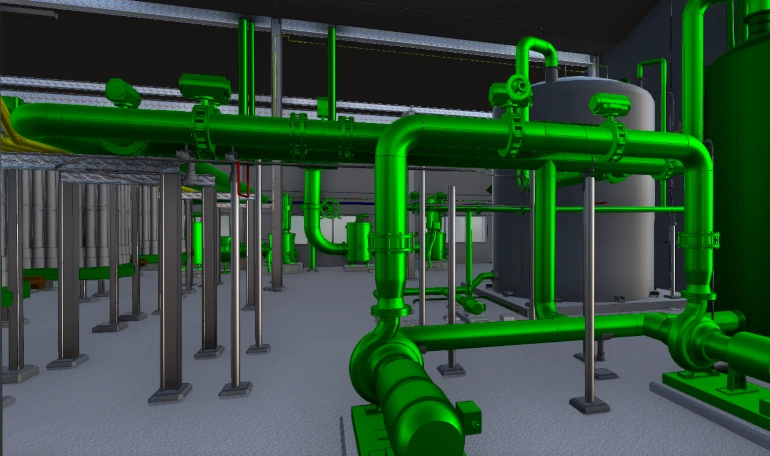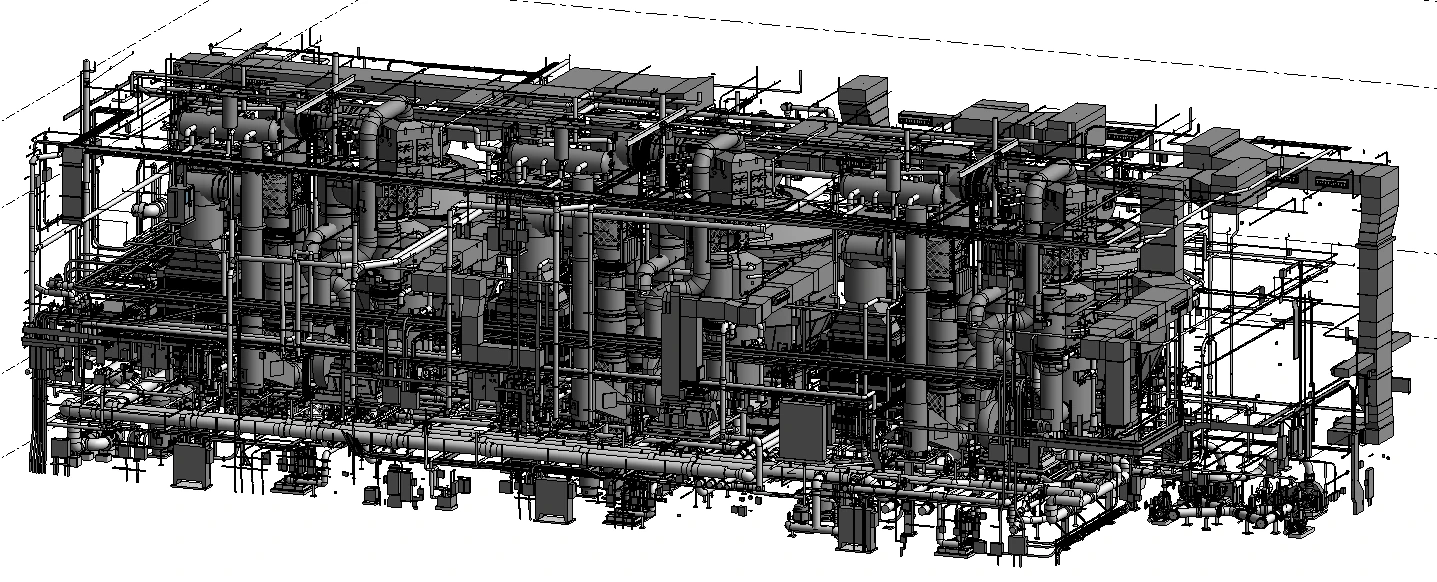For an engineer managing MEP design and execution, precision and coordination are imperative. Successful design, fabrication, and installation depend on the knowledge of existing site conditions, and reality capture via 3D laser scanning delivers just that.
With a single 3D laser scan, millions of site dimensions are captured in a point cloud, providing the data needed to create accurate 3D BIM models. BIM models allow MEP engineers to design HVAC layouts, plan electrical runs, and route plumbing systems with confidence. Plus, they help to avoid clashes, improve spatial planning, and streamline installation.
Scan-to-BIM workflows reduce human error, enhance coordination across trades, and save time during prefabrication and field installation. With advanced features like clash detection and construction sequencing, BIM technology helps MEP engineers visualize complex systems and streamline execution.

How Does 3D Laser Scanning Benefit Mechanical Contractors?
3D laser scanning delivers precise data that helps mechanical contractors improve planning, fabrication, and installation. Here’s how 3D laser scanning helps:
- Digitally capture exact MEP dimensions, layouts, and locations to minimize rework
- Reduce time spent in hazardous, hard-to-reach areas, or clean rooms
- Use BIM models to route efficient paths for HVAC, piping, and mechanical systems
- Overlay data with design models to identify clashes between mechanical systems before installation
- Prefabricate ductwork and piping assemblies with precision
What are the Benefits of 3D Laser Scanning for Electrical Contractors?
3D laser scanning offers electrical contractors a smarter, faster way to plan and execute installations with precision. 3D laser scan technology can:
- Capture exact locations of panels, conduits, junction boxes, and cable trays
- Minimize time spent in hazardous areas by capturing site data quickly
- Overlay laser scan data to build precise electrical design models
- Detect clashes between electrical systems and other trades before installation
- Plan conduit and wiring paths for maximum efficiency
- Speed up large installs with better coordination and data-driven decisions
How Does 3D Laser Scanning Help Plumbing Contractors?
3D laser scanning and BIM provide the precise data plumbing contractors need to plan efficiently, install faster, and avoid costly errors. 3D laser scanning & BIM services can:
- Capture pipe dimensions, slopes, and connections to eliminate guesswork and reduce field errors
- Visualize plumbing systems in relation to structural and MEP elements to prevent clashes and plan optimal routing
- Prefabricate assemblies with confidence in fit and alignment, minimizing rework and material waste
- Coordinate installation steps across teams to avoid delays and ensure systems are installed to spec
Case Study Example: 3D BIM Model Aids Wastewater Treatment Plant Heat Exchanger Upgrades
Faced with dense mechanical and piping systems, ABC Piping Co. turned to GPRS to 3D laser scan the Southerly Wastewater Treatment Plant and create an LOD 300 BIM model of its complex heat exchanger system. The model delivered accurate pipe sizes, routing, and spatial layout, enabling precise MEP design updates without guesswork or costly rework.
“We are delivering an architectural/structural 3D BIM model and MEP 3D BIM model for design and engineering, providing a 3D space for all disciplines to work together to identify and resolve clashes before system integration begins, ensuring a smooth retrofit with minimal rework,” Belinda Thompson, GPRS CAD Technician stated.

How Does a 3D Laser Scanner Work?
The primary way a laser scanner works is to send light pulses at high speed which reflect off objects and return to the scanner’s sensor, known as LiDAR technology. For each pulse, the distance between the scanner and object is measured by determining the elapsed time between the sent and received pulses. Each data point is converted to a pixel with a known x, y, and z coordinate for accurate reality capture.
Laser scans are taken in multiple positions around a site from varying viewpoints. Millions of data points are captured and processed into a point cloud, creating an accurate 3D as built data set of the site. This all happens very quickly, with some scanners, like the Leica RTC360, capturing and calculating 2 million points per second with 2-4 mm accuracy.
What is Scan-to-BIM?
Scan to BIM is the process of digitally capturing a site with a 3D laser scanner and using the data to create a BIM model. BIM models provide a comprehensive view of a building that can be used throughout its lifecycle – during the design phase, construction phase, and operation phase of the building.
Scan to BIM gives MEP contractors highly accurate, field-verified models that streamline design, eliminate clashes, and ensure systems fit perfectly before installation begins.
Why Choose GPRS for 3D Laser Scanning?
GPRS is the trusted leader in 3D laser scanning and BIM modeling, helping you to design and install MEP systems with precision. Our laser scanning delivers millimeter-accurate site data, capturing the exact layout, dimensions, and locations of existing system elements. This data is expertly converted into custom 2D CAD drawings and 3D BIM models that enable precise engineering, prefabrication, and fit-out. This ensures that MEP system updates are designed to fit precisely within the existing space, reduces errors and rework, and delivers superior results for your project.
Through SiteMap® (patent pending), our cloud-based GIS software platform, clients gain secure, 24/7 access to their drawings, models, and deliverables, all in one place. With GPRS, you get MEP clarity from day one and confidence throughout your build. Every GPRS customer receives complimentary Personal Level SiteMap access as part of our services.
What can we help you visualize?
Frequently Asked Questions
How does 3D laser scanning improve accuracy in MEP design?
It captures millions of precise measurements of existing site conditions, creating a reliable foundation for BIM models that help engineers design systems with confidence and avoid costly errors.
What role does scan-to-BIM play in coordinating MEP systems?
Scan-to-BIM workflows allow teams to visualize spatial relationships, detect clashes early, and plan installations that integrate seamlessly with other building components.
Can 3D laser scanning help with prefabrication and installation?
Yes, by providing exact dimensions and layouts, it enables off-site fabrication of MEP components that fit perfectly on-site, reducing rework and speeding up installation.



.svg)